Numerical Simulation on Air-Liquid Transient Flow and Regression Model on Air-Liquid Ratio of Air Induction Nozzle
Abstract
:1. Introduction
2. Materials and Methods
2.1. Test Materials
2.2. Test Equipment and Method
2.3. Numerical Simulation
2.3.1. Theoretical Analysis
2.3.2. CFD Numerical Simulation Method
- (1)
- Model building
- (2)
- Computational domain construction
- (3)
- Control Equation and model
2.3.3. Grid Partitioning
3. Results
3.1. Analysis of Air–Liquid Flow Field Distribution
3.1.1. Velocity and Pressure Distribution Analysis
3.1.2. Air–Liquid Volume Fraction Analysis
3.1.3. Air–Liquid Ratio Data Analysis
3.2. Air–Liquid Ratio Regression Model Analysis
4. Discussion
5. Conclusions
- (1)
- The CFD numerical simulation method can be used to visually analyze the flow characteristics in AIN, such as velocity, pressure, air–liquid two-phase distribution, and inlet volume of the Venturi tube. The above parameters can well describe the transient flow behavior in AIN and clarify the air–liquid coupling law in AIN.
- (2)
- The aperture ratio dp/dt of combined AIN significantly affects the distribution of air–liquid two-phase fluid. When the spray pressure is 0.6 MPa and the dp/dt is 0.76, (TD-03 model Venturi is combined with the ST 110-06 nozzle), the ALR reaches the maximum value of simulation and test measurement. The test results coincide with the simulation results.
- (3)
- By means of multivariate linear regression, a model of pressure, aperture ratio, slit width of AIN, and AIR-liquid ratio regression is established. The variance analysis shows that the model has high significance (p < 0.0001, R2 is 0.9155) and is suitable for the air–liquid ratio prediction of TD-ST combined AIN nozzle. This study provides theoretical basis and experimental guidance for the design and manufacturing of air induction nozzles with anti-drift properties.
Author Contributions
Funding
Data Availability Statement
Conflicts of Interest
References
- He, X. Advances in high efficiency plant protection machinery and precision application technology. J. Plant Prot. 2022, 49, 389–397. (In Chinese) [Google Scholar]
- He, X. Research progress of plant protection machinery and pesticide application technology in China. Chin. J. Pestic. 2019, 21, 921–930. (In Chinese) [Google Scholar]
- Lan, Y.; Chen, S. Current status and trends of plant protection UAV and its spraying technology in China. Int. J. Precis. Agric. Aviat. 2018, 1, 1–9. [Google Scholar] [CrossRef]
- Zhang, D.; Lan, Y.; Chen, L.; Wang, X.; Liang, D. Development of a charge transfer space loop to improve adsorption performance in aerial electrostatic spray. Int. J. Agric. Biol. Eng. 2020, 13, 50–55. [Google Scholar]
- Patel, M.; Praveen, B.; Sahoo, H.; Patel, B.; Kumar, A.; Singh, M. An advance air-induced air-assisted electrostatic nozzle with enhanced performance. Comput. Electron. Agric. 2017, 135, 280–288. [Google Scholar] [CrossRef]
- Cunha, J.; Barizon, R.; Ferracini, V. Spray drift and caterpilar and stink bug control from aerial applications with electrostatic charge and atomizer on soybean crop. Eng. Agric. 2017, 37, 1163–1170. [Google Scholar]
- Ozkan, H.; Miralles, A.; Sinfort, C. Shields to reduce spray drift. J. Agric. Eng. Res. 1997, 67, 311–322. [Google Scholar] [CrossRef]
- Wen, Z.; Qiu, W.; Zhang, Z.; Ding, W.; Lu, X.; Ahmad, F. Tunnel-convective air-assisted spraying technology for improving droplet deposition on hedgerow vines. Int. J. Agric. Biol. Eng. 2021, 14, 9–18. [Google Scholar] [CrossRef]
- Liu, C.; Hu, J.; Li, Y.; Zhao, S.; Zhang, W.; Li, Q. Optimization of the inner flow channel of conical wind field anti-drift spray device and anti-drift characteristics. Trans. CSAE 2021, 37, 11–20. (In Chinese) [Google Scholar]
- Gu, C.; Wang, X.; Wang, X. Research progress on variable-rate spraying technology in orchards. Appl. Eng. Agric. 2020, 36, 927–942. [Google Scholar] [CrossRef]
- Huang, Y. Characterization of spray deposition and drift from a low drift nozzle for aerial application at different application altitudes. Electron. Lett. 2011, 38, 967–968. [Google Scholar]
- Ellis, M.; Swan, T.; Miller, P.; Waddelow, S.; Bradley, A.; Tuck, C. PM—power and machinery: Design factors affecting spray characteristics and drift performance of air induction nozzles. Biosyst. Eng. 2002, 82, 289–296. [Google Scholar] [CrossRef]
- Brown, L.; Soltani, N.; Shropshire, C. Efficacy of four herbicides when applied with flat fan and air induction nozzles. Weed Biol. Manag. 2007, 7, 55–61. [Google Scholar] [CrossRef]
- Gupta, P.; Sirohi, N.; Mishra, O. Air flow characteristics of an air-assisted sprayer through horizontal crop canopy. Int. J. Agric. Biol. Eng. 2012, 5, 1–6. [Google Scholar]
- Sovani, S.; Chou, E.; Sojka, P. High pressure effervescent atomization: Effect of ambient pressure on spray cone angle. Fuel 2001, 8, 427–435. [Google Scholar] [CrossRef]
- Dorr, G.; Hewitt, A.; Adkins, S.; Hanan, J.; Zhang, H.; Noller, B. A comparison of initial spray characteristics produced by agricultural nozzles. Crop Prot. 2013, 53, 109–117. [Google Scholar] [CrossRef]
- Alisson, A.; Ulisses, R.; Rodolfo, G.; Rone, O.; Anne, S. Effect of adjuvants on the amount of air included in droplets generated by spray nozzles. Eng. Agrícola 2013, 33, 1281–1288. [Google Scholar]
- Guler, H.; Zhu, H.; Ozkan, H.; Derksen, R.; Yu, Y.; Krause, C. Spray characteristics and drift reduction potential with air induction nozzle and conventional flat-fan nozzle. Trans. ASABE 2007, 50, 745–754. [Google Scholar] [CrossRef]
- Tang, Q.; Chen, L.; Zhang, R.; Zhang, B.; Yin, C.; Xu, M.; Xu, G. Atomization characteristics of normal flat fan nozzle and air induction nozzle under high speed airflow conditions. Trans. CSAE 2016, 32, 121–128. (In Chinese) [Google Scholar]
- Vashahi, F.; Ra, S.; Choi, Y.; Lee, J. A preliminary investigation of the design parameters of an air induction nozzle. J. Mech. Sci. Technol. 2017, 31, 3297–3303. [Google Scholar] [CrossRef]
- Vashahi, F.; Ra, S.; Choi, Y.; Lee, J. Influence of design parameters on the Air/Liquid ratio of an air induction nozzle. J. Mech. 2017, 34, 375–385. [Google Scholar] [CrossRef]
- Hu, J.; Liu, C.; Wang, Z.; Li, Y.; Song, J.; Liu, Y.; Chu, X. Motion model for describing the quantity of air in droplets through changing the structure of air induction nozzle. Int. J. Agric. Biol. Eng. 2021, 14, 20–25. [Google Scholar] [CrossRef]
- Tan, H.; Wong, K.Y.; Othman, M.H.D.; Kek, H.Y.; Tey, W.Y.; Nyakuma, B.B.; Mong, G.R.; Kuan, G.; Ho, W.S.; Kang, H.S.; et al. Controlling infectious airborne particle dispersion during surgical procedures: Why mobile air supply units matter? Build. Environ. 2022, 223, 109489. [Google Scholar] [CrossRef]
- Tan, H.; Wong, K.; Lee, C.T.; Wong, S.L.; Nyakuma, B.B.; Wahab, R.A.; Lee, K.Q.; Chiong, M.C.; Ho, W.S.; Othman, M.H.D.; et al. Numerical assessment of ceiling-mounted air curtain on the particle distribution in surgical zone. J. Therm. Anal. Calorim. 2022. [Google Scholar] [CrossRef]
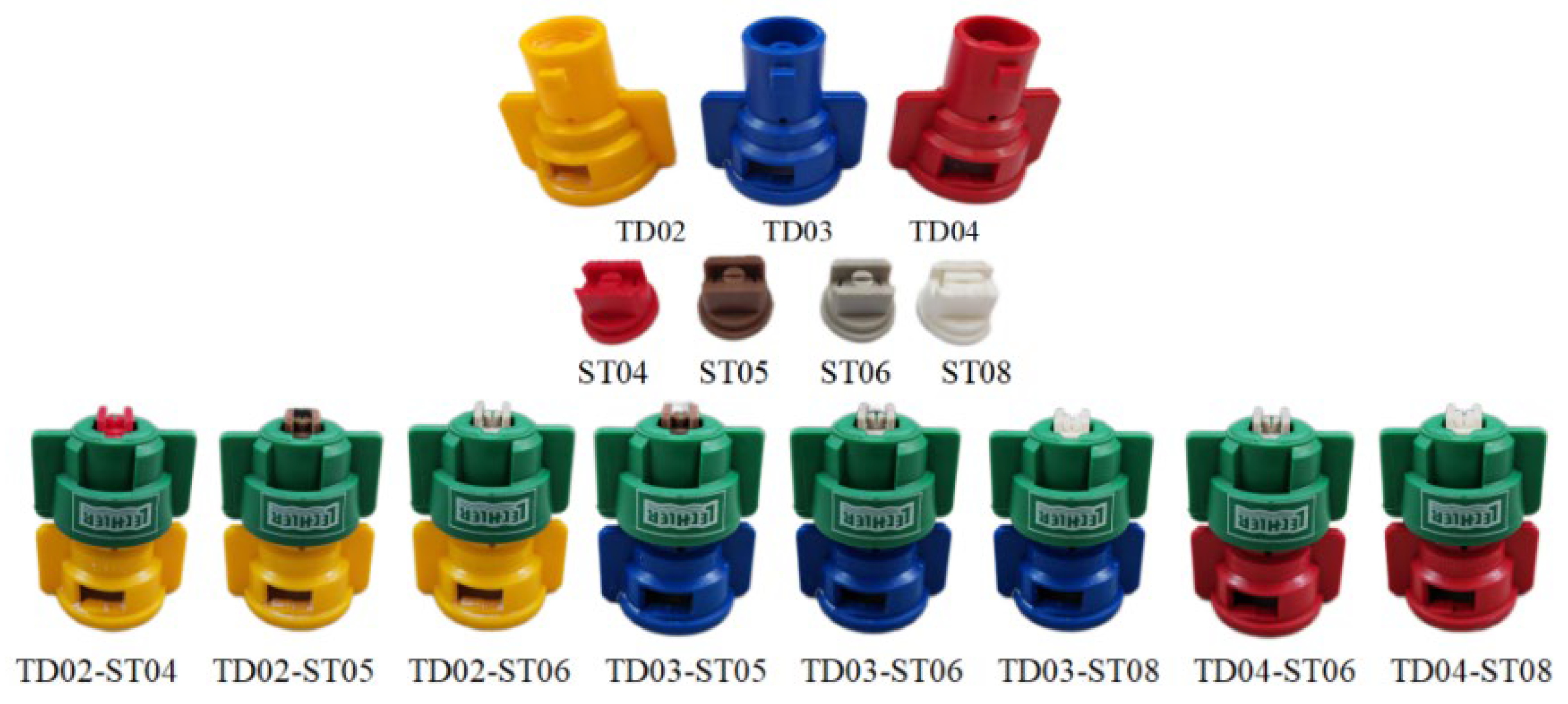
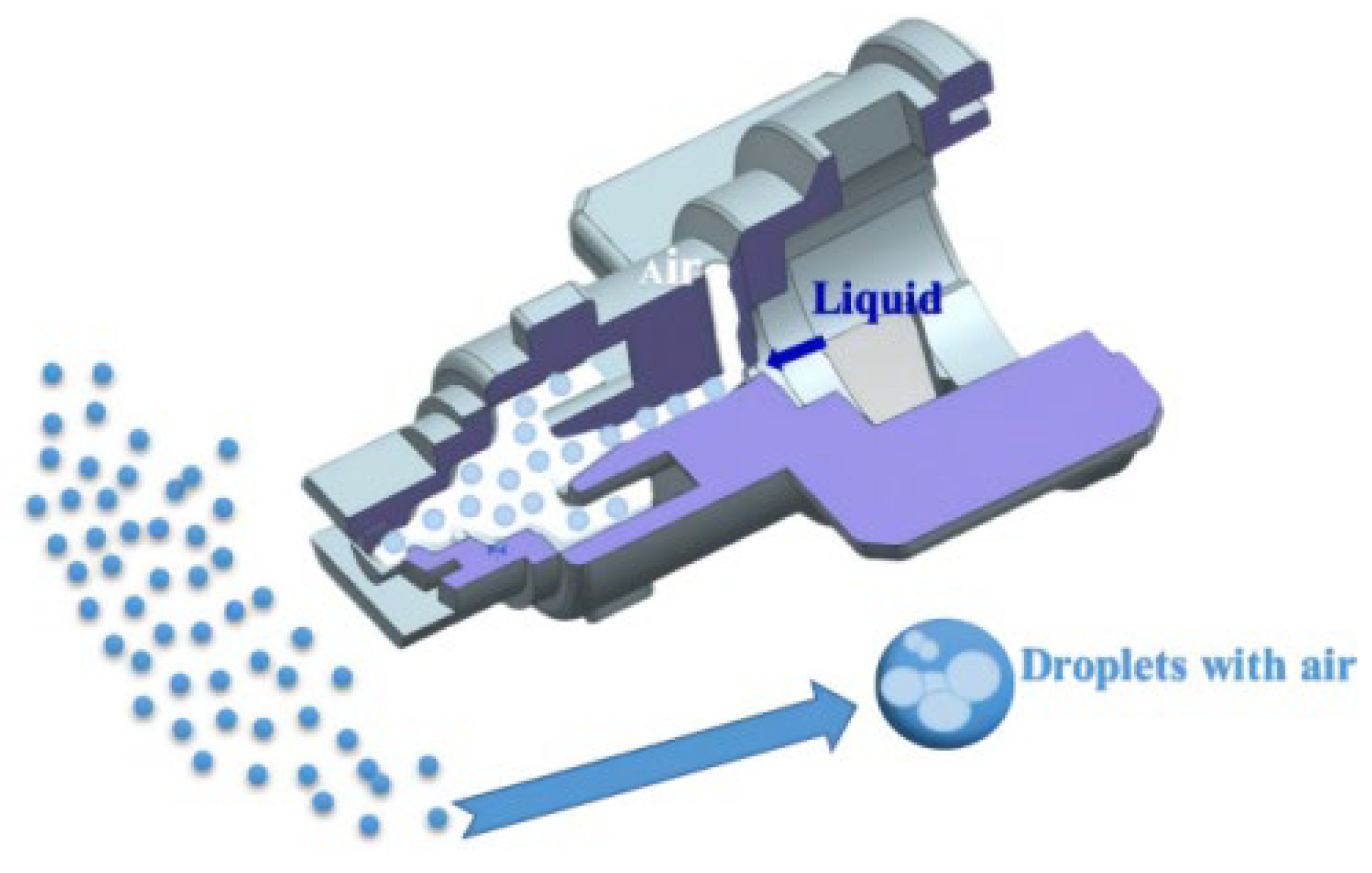



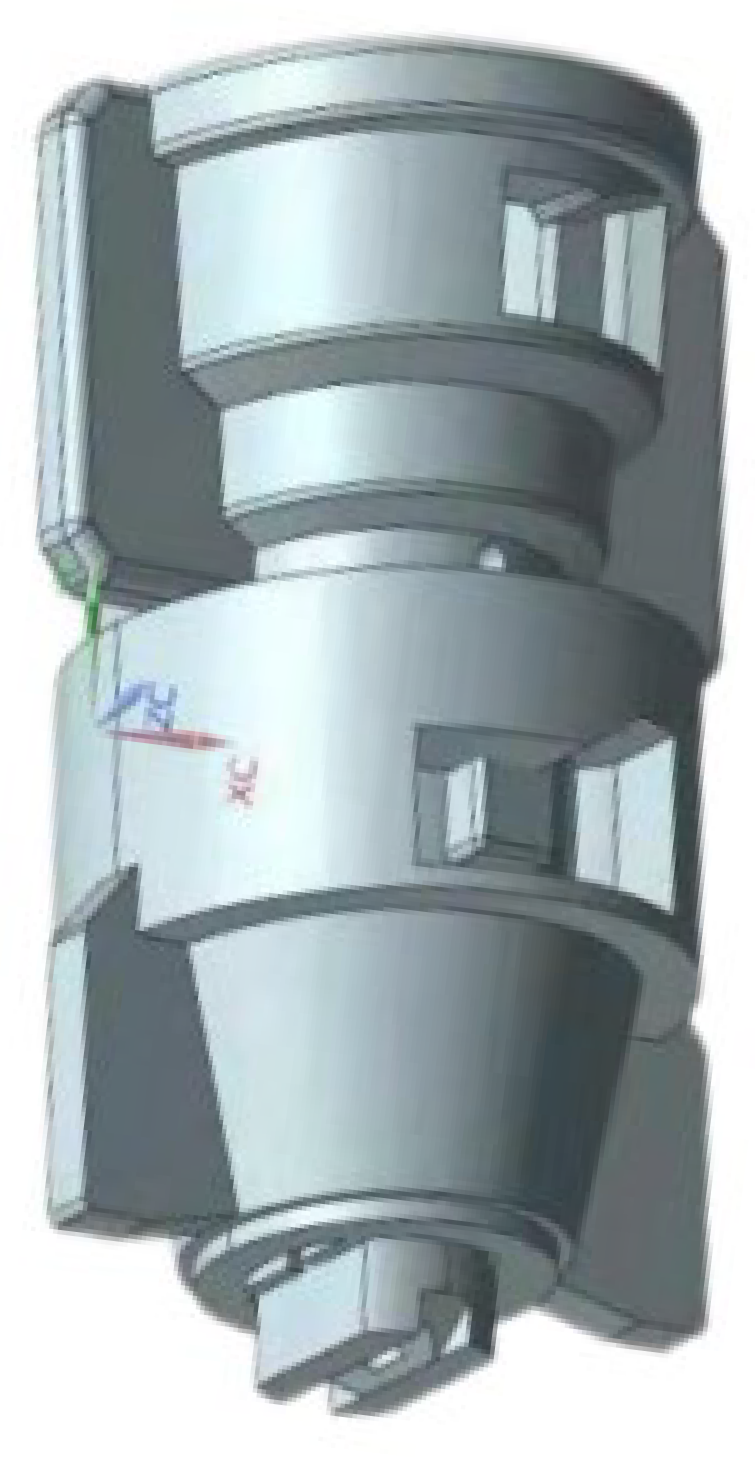
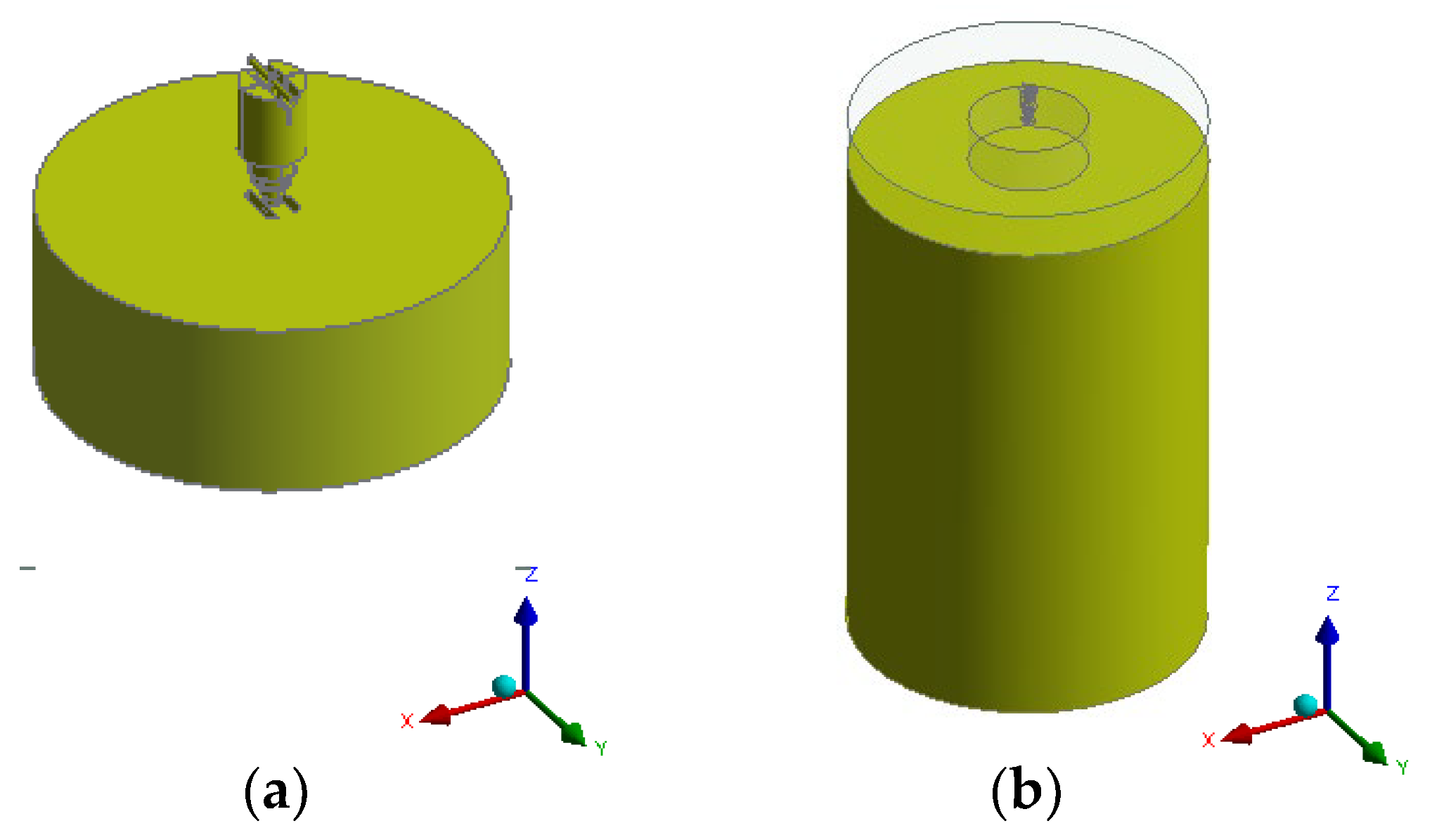
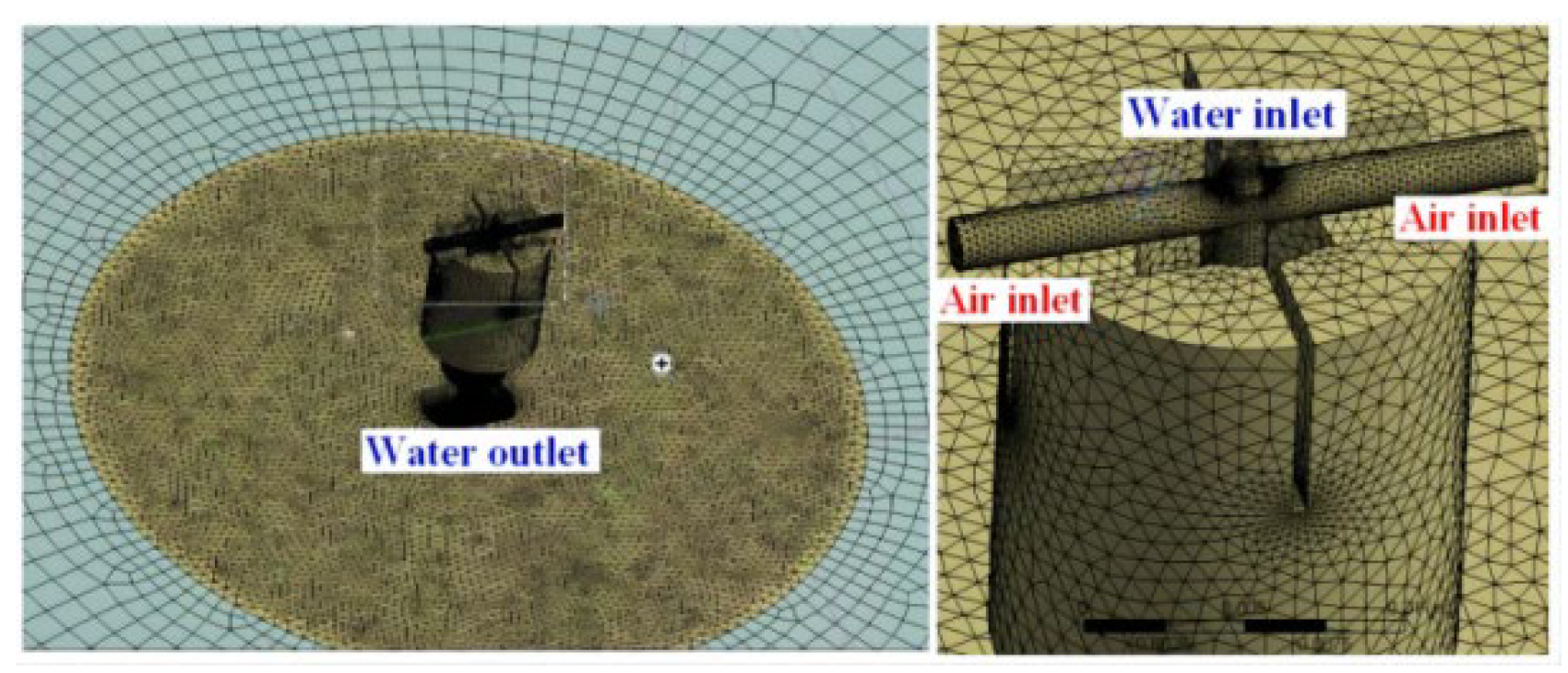

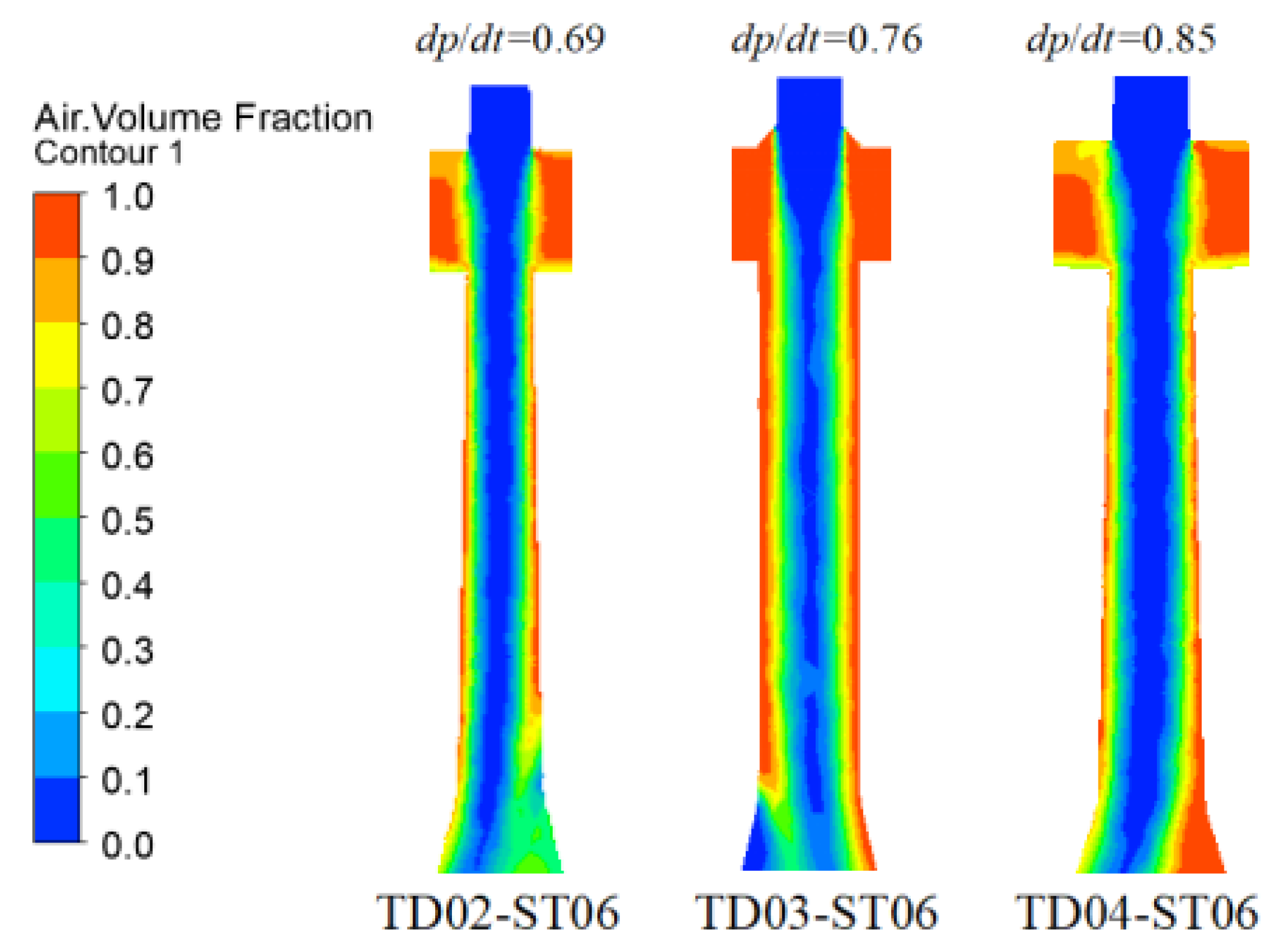
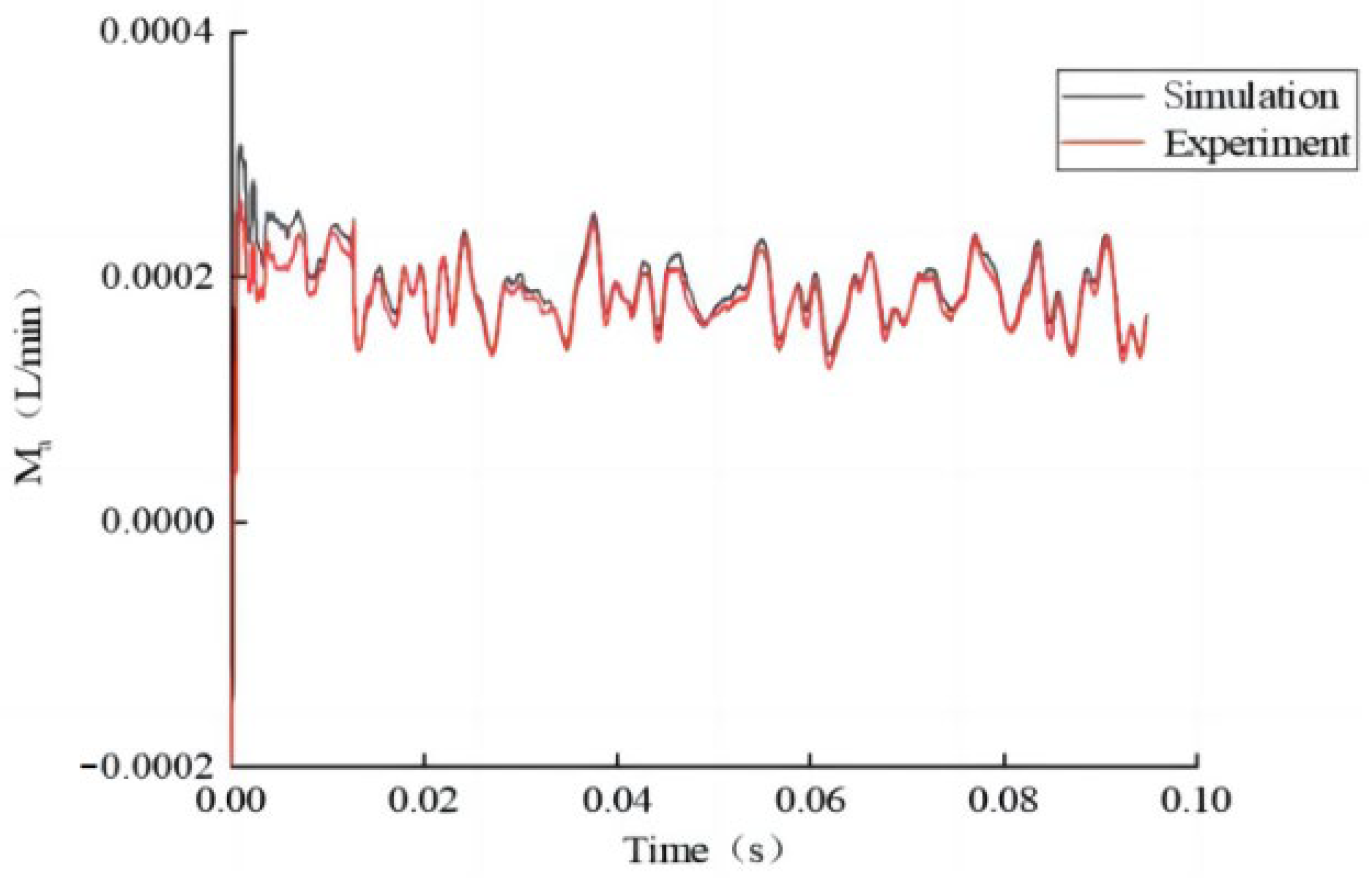
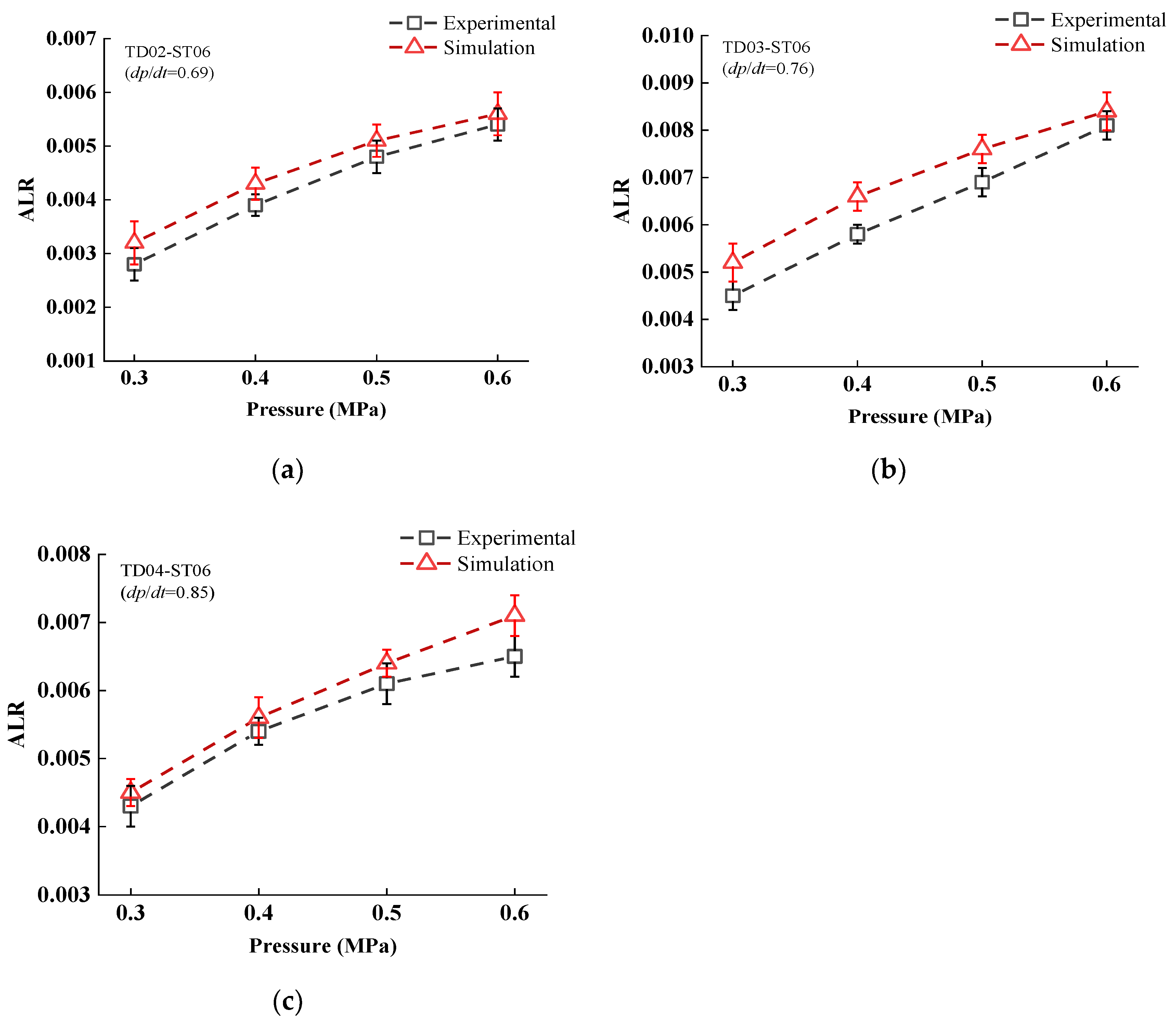
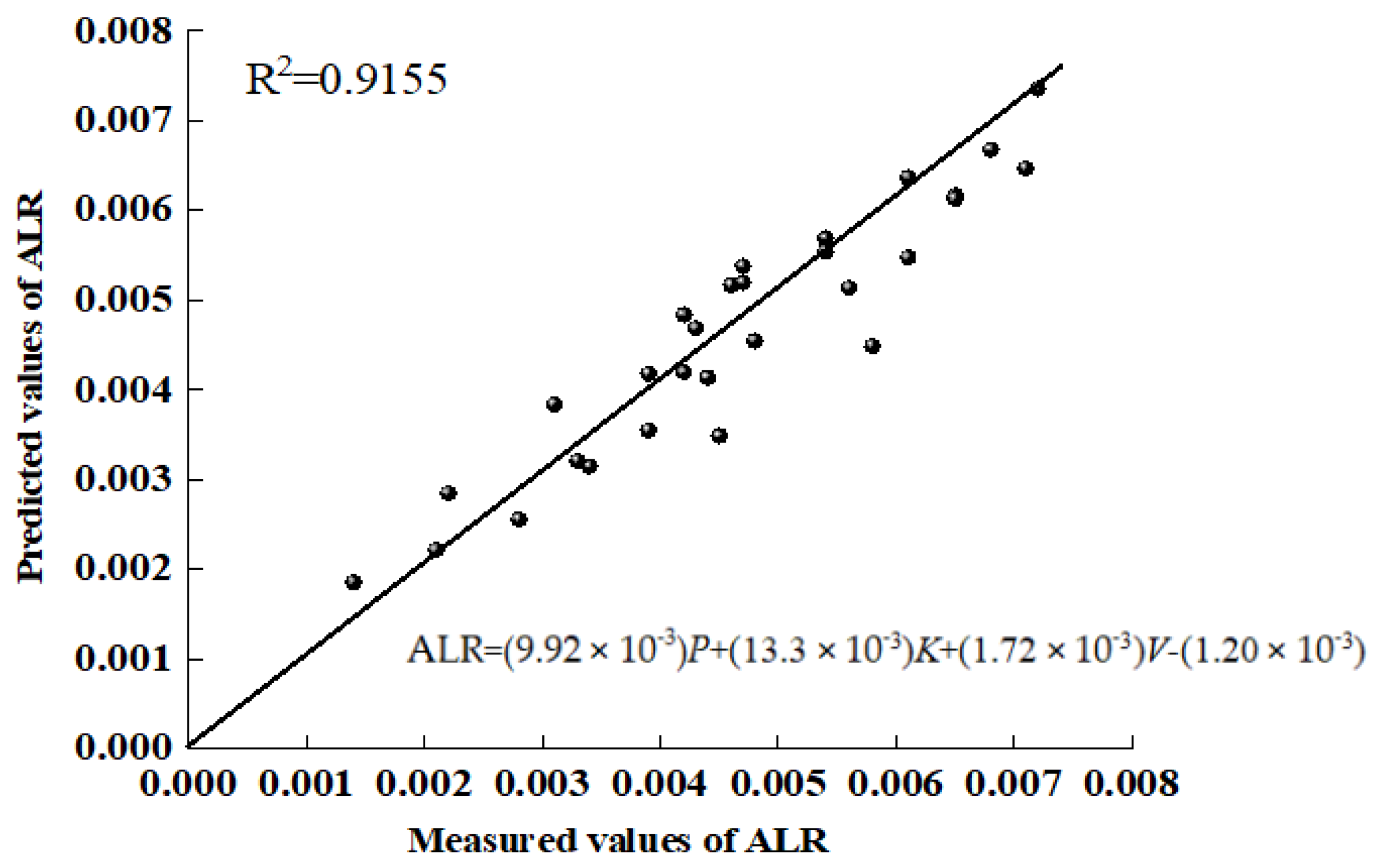
| Project | Grid Quantity | |||
|---|---|---|---|---|
| A/1.3 Million | B/1.6 Million | C/2.0 Million | D/2.2 Million | |
| maximum speed/(m·s−1) | 2.374 | 2.545 | 2.587 | 2.612 |
| outlet speed/(m·s−1) | 2.133 | 2.424 | 2.473 | 2.494 |
| maximum pressure/(MPa) | 0.152 | 0.183 | 0.192 | 0.198 |
Volume Fraction of Air | |||||
|---|---|---|---|---|---|
| Nozzle Type | Pressure (MPa) | A-A′ | Ma (L/min) | Ml (L/min) | Ma/Ml |
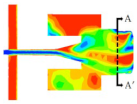 TD02-ST06 | 0.4 |  | 0.0036 | 0.95 | 0.0038 |
| 0.5 |  | 0.0044 | 1.08 | 0.0041 | |
| 0.6 |  | 0.0051 | 1.16 | 0.0044 | |
 TD03-ST06 | 0.4 |  | 0.0061 | 1.58 | 0.0039 |
| 0.5 |  | 0.0078 | 1.79 | 0.0044 | |
| 0.6 |  | 0.0092 | 1.96 | 0.0047 | |
 TD04-ST06 | 0.4 |  | 0.0045 | 1.98 | 0.0022 |
| 0.5 |  | 0.0073 | 2.21 | 0.0033 | |
| 0.6 |  | 0.0089 | 2.46 | 0.0036 | |
| Pressure (P)/MPa | Aperture Ratio (K) | Slit Width (V)/mm | ALR | Pressure (P)/MPa | Aperture Ratio (K) | Slit Width (V)/mm | ALR |
|---|---|---|---|---|---|---|---|
| 0.3 | 0.69 | 0.99 | 0.0014 | 0.4 | 0.69 | 0.99 | 0.0022 |
| 0.69 | 1.20 | 0.0021 | 0.69 | 1.20 | 0.0033 | ||
| 0.69 | 1.40 | 0.0028 | 0.69 | 1.40 | 0.0039 | ||
| 0.76 | 1.20 | 0.0034 | 0.76 | 1.20 | 0.0044 | ||
| 0.76 | 1.40 | 0.0045 | 0.76 | 1.40 | 0.0058 | ||
| 0.76 | 1.80 | 0.0039 | 0.76 | 1.80 | 0.0046 | ||
| 0.85 | 1.40 | 0.0043 | 0.85 | 1.40 | 0.0054 | ||
| 0.85 | 1.80 | 0.0047 | 0.85 | 1.80 | 0.0061 | ||
| 0.5 | 0.69 | 0.99 | 0.0031 | 0.6 | 0.69 | 0.99 | 0.0042 |
| 0.69 | 1.20 | 0.0042 | 0.69 | 1.20 | 0.0047 | ||
| 0.69 | 1.40 | 0.0048 | 0.69 | 1.40 | 0.0054 | ||
| 0.76 | 1.20 | 0.0056 | 0.76 | 1.20 | 0.0065 | ||
| 0.76 | 1.40 | 0.0061 | 0.76 | 1.40 | 0.0071 | ||
| 0.76 | 1.80 | 0.0065 | 0.76 | 1.80 | 0.0069 | ||
| 0.85 | 1.40 | 0.0068 | 0.85 | 1.40 | 0.0078 | ||
| 0.85 | 1.80 | 0.0072 | 0.85 | 1.80 | 0.0081 |
| Factor | Unstandardized Coefficient | Standardized Coefficient | Value T | 95% CI (Asymptotic) | |
|---|---|---|---|---|---|
| Value B | Standard Error | Value Beta | |||
| (Constant) | −0.001201 | −0.001208 | 9.947 | −0.01449 to −0.009539 | |
| Pressure (P) | 0.009924 | 0.000823 | −2.0688 | 12.05 | 0.008238 to 0.01161 |
| Aperture ratio (K) | 0.01333 | 0.001846 | 3.4095 | 7.219 | 0.009547 to 0.01711 |
| Slit width (V) | 0.001715 | 0.000429 | −4.7211 | 3.987 | 0.0008332 to 0.002594 |
| Type | Sum of Square | Degree of Freedom | Mean Square | Significance |
|---|---|---|---|---|
| Pressure (P) | 3.940 × 10−5 | 1 | 3.940 × 10−5 | p < 0.0001 |
| Aperture ratio (K) | 1.414 × 10−5 | 1 | 1.414 × 10−5 | p < 0.0001 |
| Slit width (V) | 4.312 × 10−5 | 1 | 4.312 × 10−5 | p < 0.0001 |
| Regression | 8.233 × 10−5 | 3 | 2.744 × 10−5 | p < 0.0004 |
| Residual | 7.597 × 10−5 | 28 | 2.713 × 10−5 | |
| Total | 8.992 × 10−5 | 31 |
Disclaimer/Publisher’s Note: The statements, opinions and data contained in all publications are solely those of the individual author(s) and contributor(s) and not of MDPI and/or the editor(s). MDPI and/or the editor(s) disclaim responsibility for any injury to people or property resulting from any ideas, methods, instructions or products referred to in the content. |
© 2023 by the authors. Licensee MDPI, Basel, Switzerland. This article is an open access article distributed under the terms and conditions of the Creative Commons Attribution (CC BY) license (https://creativecommons.org/licenses/by/4.0/).
Share and Cite
Liu, C.; Hu, J.; Li, Y.; Zhao, S.; Li, Q.; Zhang, W. Numerical Simulation on Air-Liquid Transient Flow and Regression Model on Air-Liquid Ratio of Air Induction Nozzle. Agronomy 2023, 13, 248. https://doi.org/10.3390/agronomy13010248
Liu C, Hu J, Li Y, Zhao S, Li Q, Zhang W. Numerical Simulation on Air-Liquid Transient Flow and Regression Model on Air-Liquid Ratio of Air Induction Nozzle. Agronomy. 2023; 13(1):248. https://doi.org/10.3390/agronomy13010248
Chicago/Turabian StyleLiu, Changxi, Jun Hu, Yufei Li, Shengxue Zhao, Qingda Li, and Wei Zhang. 2023. "Numerical Simulation on Air-Liquid Transient Flow and Regression Model on Air-Liquid Ratio of Air Induction Nozzle" Agronomy 13, no. 1: 248. https://doi.org/10.3390/agronomy13010248
APA StyleLiu, C., Hu, J., Li, Y., Zhao, S., Li, Q., & Zhang, W. (2023). Numerical Simulation on Air-Liquid Transient Flow and Regression Model on Air-Liquid Ratio of Air Induction Nozzle. Agronomy, 13(1), 248. https://doi.org/10.3390/agronomy13010248







